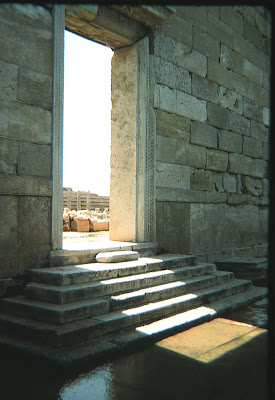

Extensively restored by the Italians in the 1920s, the theatre is certainly impressive.

.

The front of the stage is adorned with a number of bas-reliefs.



.
.
A collection of photographs taken by Jeff Mohamed in North Africa and the Middle East between 1970 and 1985.



.

The front of the stage is adorned with a number of bas-reliefs.



.
.








The Nile at Luxor
 The Nile at Aswan
The Nile at Aswan

Sunset over the Nile
In ancient times, the river was the quickest and easy way to travel between Upper and Lower Egypt, and it is still a significant thoroughfare for the transportation of goods within the country.

The graceful felucca is still a common sight on the river

Three feluccas at Aswan

A felucca boatman near Aswan
When you travel up or down the Nile, you cannot help be struck by the lushness of the vegetation on both sides of the river. And by the way the river has fostered human life along its banks for thousands of years.






However, you are also frequently reminded of the fact that most of Egypt is desert, and that the desert is constantly trying to take over the fields and farms which line the river. 

 The main public buildings
The main public buildings
Although much of the city was destroyed by an earthquake in the 4th Century AD, it was not abandoned until the Arab invasions in the late 7th Century. The remaining buildings were destroyed by the great Lisbon earthquake of 1755. Archaeological excavations began in the early 1900s and several major buildings have since been restored.
These days, the site attracts large numbers of visitors, drawn mainly by its imposing public buildings and by the mosaic floors contained in several mansions.
The Public Buildings
The main public buildings are a triumphal arch, a basilica and a capitol, all built under the Emperor Caracalla in the early 3rd Century AD.
 The triumphal arch was originally topped by a bronze chariot
The triumphal arch was originally topped by a bronze chariot
 The basilica
The basilica

Monumental arches in the basilica wall

The steps and columns of the capitol
Water was supplied by an aqueduct , which ran along the side of the main street.

Remains of the aqueduct
As everywhere in the Roman Empire, the public baths were heated by hot air channelled under the floors and behind the walls.
 The underfloor heating system
The underfloor heating system
Private Houses and Mosaics
The city's streets are lined with the mansions of wealthy landowners and merchants, and many of these mansions still contain fine examples of mosaic floors.


Several of the mosaics show scenes from mythology.
Others show animals of the types exported to be displayed - and killed - in Roman arenas.

Others have more prosaic subjects, such as local hunting trips.

Some are comparatively crude and less colourful.
Olive Oil Factories
Throughout the city there are remains of factories where olive oil was produced.
The photo below shows the round stone plate on which baskets of olive mash were placed and then crushed by a heavy stone block lifted and lowered by a pulley system. 
The oil ran into the channel around the stone plate and through a groove into a square pit (centre left in the photo). Water was poured into the pit and then the oil was scooped off the surface into earthenware jugs ("amphorae").
 The slots in the foreground held the pulley supports
The slots in the foreground held the pulley supports


 Looking down into an underground house
Looking down into an underground house
Each house has several rooms grouped around a central open courtyard.

You enter the house via a large doorway and a sloping ramp.
